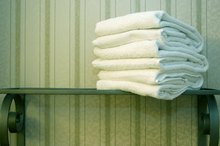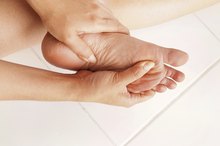How to Treat Vaginal Yeast Infections in Children
Yeast, the common name for the fungus Candida, almost always lives in certain moist parts of our bodies, usually without causing any ill-effect. Sometimes, yeast overgrowth can occur, which leads to irritating symptoms and the need for treatment. Yeast infections can affect anyone at any age 1. The vagina is a common place for a yeast infection, and although it can be distressing for parents, children can get infections there as well 1. Luckily, treatment for vaginal yeast infections in children is generally safe and effective 1.
If you are experiencing serious medical symptoms, seek emergency treatment immediately.
Speak with your child's physician. If this is your child's first yeast infection, he will want you to schedule a visit.
Jock Itch in Children
Learn More
Use an over-the-counter medication to treat the infection 1. Diflucan can be taken orally and is very effective in clearing up infections. Creams containing miconazole, such as Monistat, are typically effective as well. However, miconazole is only recommended for use in children over the age of 12, unless under the direction of your doctor. Regardless of age, make sure to okay any medication with your doctor before use.
Make sure your child's skin can breath. If your child isn't potty-trained, diapers are still a must, but avoid those plastic panties that don't allow air to circulate. You also may want to consider putting away any tight pants or undergarments your daughter might have, and opt for looser fitting clothing. Underwear made of breathable, natural fibers like cotton will help prevent reinfection.
How Long Does a Yeast Infection Last Without Medication?
Learn More
Damp skin can hinder healing. Damp environments encourage yeast growth, so make sure if your daughter goes swimming, she doesn't stay in her wet suit for long. Also, make sure her genital area is thoroughly dried after swimming or baths.
Eat well. A good diet can go a long way toward inhibiting yeast overgrowth, which typically starts in the GI tract. Add whole grains and vegetables, and cut back on fatty foods and sugars. Also, garlic is a natural antifungal, so adding it to your daughter's diet can help control yeast.
Add probiotics. Probiotics are beneficial bacteria that help fight the cause of yeast overgrowth in the gut. Adding probiotic supplements with acidophilus or eating yogurt with live cultures can help kill off the infection naturally.
Tips
Antibiotics are often a culprit in yeast infections. Try adding probiotics or a daily dose of yogurt with live cultures to your daughter's diet the day she starts antibiotics, to prevent recurrence of infections.
Related Articles
References
- Medicine Net--Thrush and Other Yeast Infections
- Planned Parenthood. What is a yeast infection?
- InformedHealth.org [Internet]. Cologne, Germany: Institute for Quality and Efficiency in Health Care (IQWiG); 2006-. Vaginal yeast infection (thrush): Overview. 2019 Jun 19.Available from: https://www.ncbi.nlm.nih.gov/books/NBK543220/
- Singh A, Verma R, Murari A, Agrawal A. Oral candidiasis: An overview. J Oral Maxillofac Pathol. 2014;18(Suppl 1):S81–S85. doi:10.4103/0973-029X.141325
- Jeanmonod R, Jeanmonod D. Vaginal Candidiasis (Vulvovaginal Candidiasis) [Updated 2020 Feb 4]. In: StatPearls [Internet]. Treasure Island (FL): StatPearls Publishing; 2020 Jan-. Available from: https://www.ncbi.nlm.nih.gov/books/NBK459317/
- InformedHealth.org [Internet]. Cologne, Germany: Institute for Quality and Efficiency in Health Care (IQWiG); 2006-. Oral thrush: Overview. 2012 Apr 26 [Updated 2019 Aug 15].Available from: https://www.ncbi.nlm.nih.gov/books/NBK367586/
- Blostein F, Levin-sparenberg E, Wagner J, Foxman B. Recurrent vulvovaginal candidiasis. Ann Epidemiol. 2017;27(9):575-582.e3. doi:10.1016/j.annepidem.2017.08.010
- Aguin TJ, Sobel JD. Vulvovaginal candidiasis in pregnancy. Curr Infect Dis Rep. 2015;17(6):462. doi:10.1007/s11908-015-0462-0
- Rajalakshmi R, Kalaivani S. Prevalence of asymptomatic infections in sexually transmitted diseases attendees diagnosed with bacterial vaginosis, vaginal candidiasis, and trichomoniasis. Indian J Sex Transm Dis AIDS. 2016;37(2):139–142. doi:10.4103/0253-7184.192121
- Ringdahl EN. Treatment of recurrent vulvovaginal candidiasis. Am Fam Physician. 2000;61(11):3306-12, 3317.
- Aguin TJ, Sobel JD. Vulvovaginal candidiasis in pregnancy. Curr Infect Dis Rep. 2015 Jun;17(6):462. doi: 10.1007/s11908-015-0462-0.
- Blostein F, Levin-Sparenberg E, Wagner J, Foxman B. Recurrent vulvovaginal candidiasis. Ann Epidemiol. 2017 Sep;27(9):575-582.e3. doi: 10.1016/j.annepidem.2017.08.010.
- Chew SY, Than LT. Vulvovaginal candidosis: contemporary challenges and the future of prophylactic and therapeutic approaches. Mycoses. 2016 May;59(5):262-73. doi: 10.1111/myc.12455.
- Roberts CL, Algert CS, Rickard KL, Morris JM. Treatment of vaginal candidiasis for the prevention of preterm birth: a systematic review and meta-analysis. Syst Rev. 2015 Mar 21;4:31. doi: 10.1186/s13643-015-0018-2.
- Xie HY, Feng D, Wei DM, Mei L, Chen H, Wang X, Fang F. Probiotics for vulvovaginal candidiasis in non-pregnant women. Cochrane Database Syst Rev. 2017 Nov 23;11:CD010496. doi: 10.1002/14651858.CD010496.pub2.
Tips
- Antibiotics are often a culprit in yeast infections. Try adding probiotics or a daily dose of yogurt with live cultures to your daughter's diet the day she starts antibiotics, to prevent recurrence of infections.









